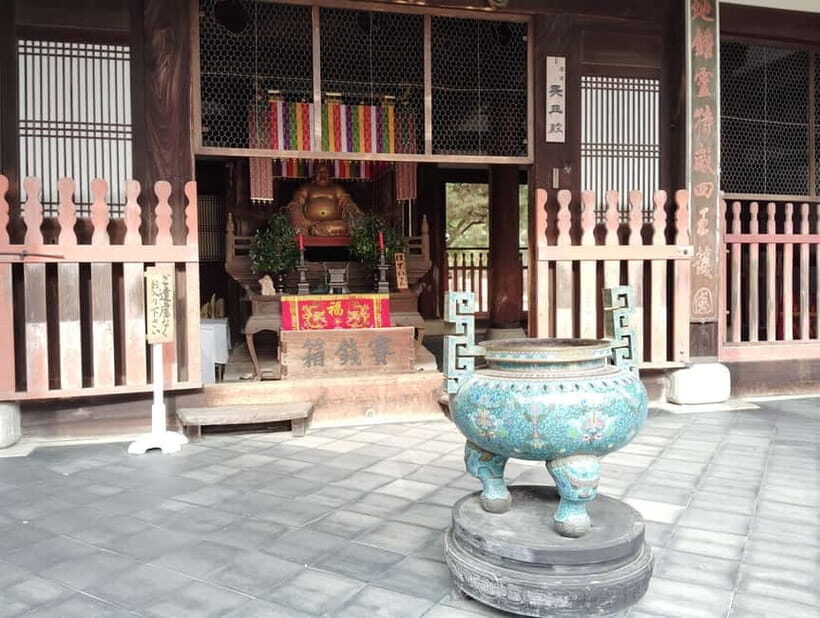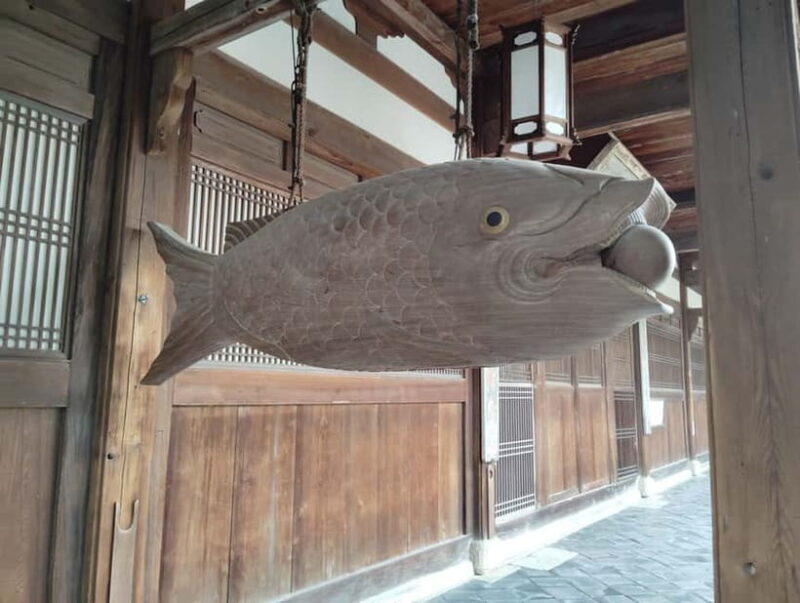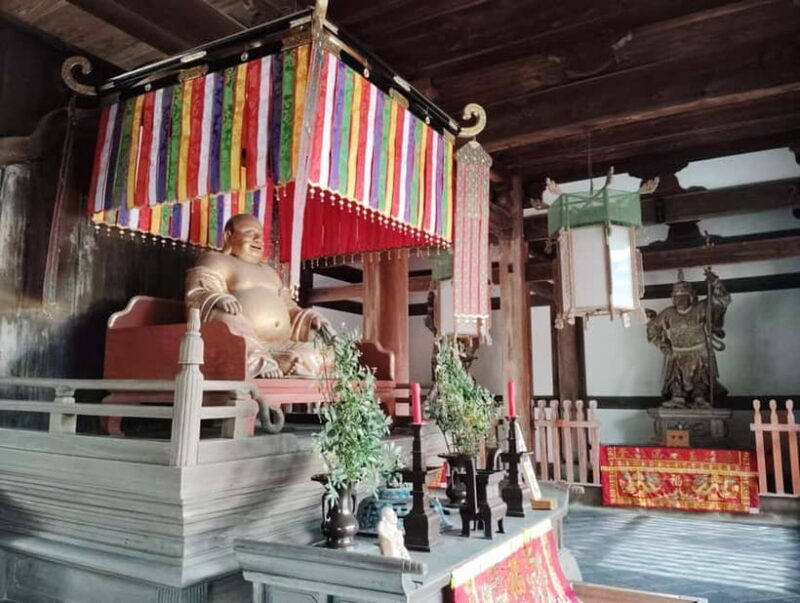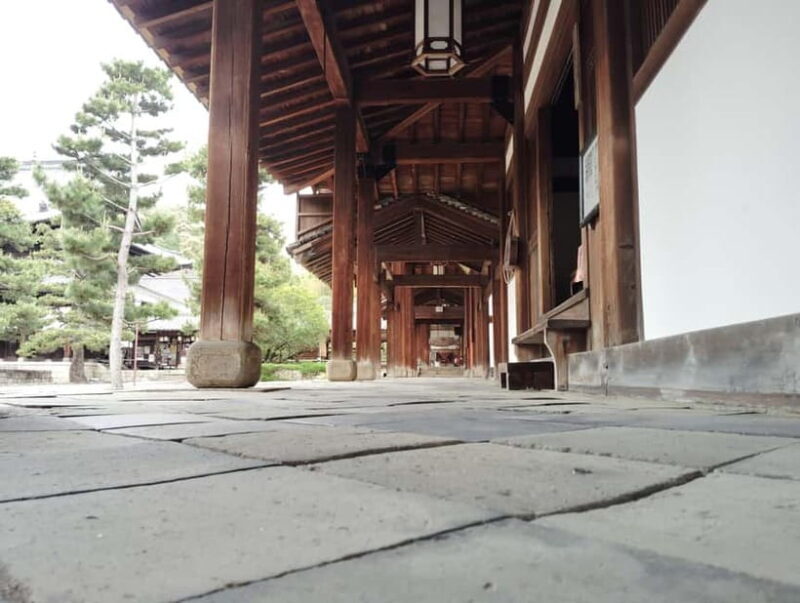Kyoto: Journey to Manpuku-ji, Uji’s Best-Kept Secret
Imagine wandering through a tranquil temple that feels a world away from bustling Kyoto, yet is just a short train ride from the city’s famous landmarks. For $51 per person, this guided tour offers an opportunity to explore Manpuku-ji, a serene Zen temple in Uji with roots going back to 1661. Led by a knowledgeable guide (whose warmth and stories really add to the experience), you’ll visit the temple’s stunning Chinese Ming dynasty-style architecture, admire a striking Buddha statue, and soak in the peaceful atmosphere.
What truly makes this tour memorable are two aspects: first, the Chinese influence that stands out amidst typical Japanese temples—think vibrant vermilion gates and curved rooflines—giving you a glimpse of a different cultural fusion; second, the calm, contemplative vibe—the gentle rustling of trees and faint monks’ chants—makes it more than just a sightseeing stop. It’s an experience of quiet reflection. The one thing to consider is that this tour is not a quick, hurried visit, so if you prefer fast-paced sights, it might feel slow. Still, it’s perfect for travelers craving authenticity and peacefulness, especially those interested in architecture, Zen Buddhism, or Chinese-Japanese cultural exchanges.
Key Points
- Unique architecture: Chinese Ming dynasty style, with curved rooftops and vermilion gates.
- Cultural fusion: Reflects a blend of Chinese influence in a Japanese setting.
- Peaceful atmosphere: Serene environment, soft monk chants, rustling trees.
- Historical significance: Founded in 1661 by Chinese monk Ingen Ryuki.
- Accessible location: Just minutes from Obaku Station, near Uji’s tea attractions.
- Value for money: At $51, it includes a guided tour of an uncommon, culturally rich site.
Exploring Manpuku-ji: A Hidden Treasure in Uji

We loved how this tour transports you to a different time and place, all within a quiet corner of Uji. While Uji is celebrated for its matcha tea and the famous Byodoin Temple, many visitors overlook Manpuku-ji, which is equally steeped in history. Founded by Chinese monk Ingen Ryuki, this temple is the head of the Obaku school of Zen Buddhism, and its architecture is a rare example of Ming dynasty Chinese style in Japan.
What makes this temple so special? For starters, the architecture is unlike typical Japanese Zen temples. Instead of simple wooden structures, you’ll see symmetrical grounds, vibrant vermilion gates, lattice windows, and curved rooftops that immediately suggest Chinese craftsmanship. The visual contrast makes it stand out among Uji’s more traditional temples and offers a great photo opportunity. As one review notes, “It’s a chance to see a little piece of China right here in Japan,” which is a pretty accurate description.
This fusion of styles isn’t just aesthetic—it’s a glimpse into the cultural exchange that took place in the Edo period. The Chinese influence, brought by Ingen Ryuki, is still palpable today. The Tenno-den Hall, the main hall, houses a striking Shakyamuni Buddha statue, flanked by 18 arhats with expressive faces that add a layer of lively character to the spiritual scene. The quiet, respectful atmosphere encourages reflection, which is exactly what Zen is all about.
Planning more time in Kyoto? We've covered other experiences worth considering.
The Itinerary Breakdown

The tour begins at JR Baku Station, where your guide will be waiting with a yellow “DeepExperience” sign. From there, it’s a short walk to Manpuku-ji, approximately five minutes from Obaku Station—an easy and accessible location, especially if you’re already exploring Uji’s more popular sites.
Once inside, you’ll be introduced to the unique architecture of the temple grounds. The symmetrical layout is pleasing and invites a gentle stroll through the courtyards. We loved the way the architecture emphasizes balance, harmony, and the Chinese aesthetic, which feels distinct from Japanese temples that often prioritize simplicity and natural materials.
The highlight is the Tenno-den Hall, where the Buddha statue resides. The guide will likely offer insights about the Obaku school and the significance of the statues and arhats. Listening to the subtle sounds of chanting—not loud or intrusive—adds to the sense of being in a sacred space. We found it profoundly peaceful, a perfect moment for a mindful pause.
The entire visit lasts about an hour, with plenty of time to explore, take photos, and absorb the atmosphere. Since the tour is guided, you’ll get enriching stories about the temple’s background, its Chinese roots, and its place in Uji’s cultural landscape.
The Architecture: A Chinese Ming Dynasty Masterpiece

What immediately catches the eye at Manpuku-ji is its architecture, which is a tangible link to 14th-century China. The curved roofs are adorned with decorative tiles, and the vermillion gates stand out vividly against the green surroundings. The symmetry of the grounds creates a sense of order and calm, aligning perfectly with Zen principles.
Many visitors mention their fascination with how different it feels from other Japanese temples. One quote from a traveler says, “It’s like stepping into a Chinese painting, with the vibrant colors and intricate details.” This design choice was deliberate by Ingen Ryuki, aiming to bring the Chinese Zen tradition to Japan, and it has been beautifully preserved.
The lattice windows and the layout of the halls foster a sense of openness and light, inviting visitors to contemplate and reflect. The visual harmony makes a strong impression, especially since these features are quite distinct from the more subdued Japanese temple styles.
The Buddha and the Arhats: Art and Spirituality

The statue of Shakyamuni Buddha in the Tenno-den Hall is a focal point of reverence. It’s described as striking and well-preserved, showcasing craftsmanship that combines spiritual symbolism with artistic skill. Flanked by 18 arhats with expressive faces, the statues contribute a lively and approachable aspect to the temple’s spiritual environment.
Many reviews highlight how these statues add character and a human touch to the experience. One visitor remarked, “The arhats’ faces are so expressive; it’s like meeting a cast of characters from a story.” For those interested in Buddhist art, this collection offers both aesthetic beauty and cultural insight.
More Great Tours NearbyThe Peaceful Atmosphere

Beyond the physical features, what we loved most was the serene ambiance. The soft rustling of leaves, the faint chants of monks, and the overall quietness create a meditative space. It’s an environment that encourages you to slow down, breathe deeply, and appreciate the stillness.
This atmosphere makes the visit more than just a sightseeing stop; it becomes a moment of mindfulness that travelers often cherish. If you’re into mindfulness or simply seeking a break from busy tourist spots, this tour provides a gentle, contemplative experience.
- 2-Hour Shopping Tour Plan / private
- 6-Day Private Tour to Kyoto via Fukui from Fukuoka with Bus
- 2 Types of Japanese Sweets making and Tea Ceremony
- Kyoto: Insider Sake Brewery Tour with Sake and Food Pairing
- 4.5-hr Kyoto Historical Highlights Bike Tour with UNESCO
- 4-Day Scenic Japan Tour by Car: Tokyo Mt. Fuji Kyoto & Osaka
Practical Tips: Making the Most of Your Visit
Since the tour is only about an hour, it’s perfect if you’re already exploring Uji or have a few hours between other activities. It’s worth noting that the location is easy to reach, just a few minutes walk from Obaku Station. You don’t need to worry about complicated transportation, which adds to the convenience.
The price of $51 covers the guided tour, which is quite reasonable given the depth of information and the uniqueness of the site. We think this is a good value for anyone interested in architecture, history, or Zen Buddhism.
One thing to keep in mind: because it’s a guided tour, you’ll want to arrive on time to ensure you get the full experience. Also, the tone of the tour is calm and respectful, making it suitable for travelers of all ages, but less ideal if you’re expecting lively entertainment.
Who Should Consider This Tour?

This experience is ideal for culture enthusiasts eager to see something different from the usual temples. It’s also perfect for architecture lovers wanting to appreciate a Chinese influence in Japan. If you’re seeking a peaceful, contemplative environment that offers a deep sense of history and artistry, this tour will resonate with you.
Travelers interested in Japanese and Chinese cultural exchanges, or those simply looking for a quiet retreat in Uji, will find this tour especially rewarding. It’s also a good choice if you’re in Uji for its famous matcha and want to add a meaningful cultural stop to your itinerary.
FAQ

Is the tour suitable for all ages?
Yes, the peaceful nature and short duration make it appropriate for all ages. The environment is calm and respectful, ideal for families or solo travelers seeking serenity.
How long does the tour last?
The guided visit lasts about an hour, giving enough time to explore the grounds, appreciate the architecture, and absorb the atmosphere without feeling rushed.
Is transportation included?
No, the tour meeting point is at JR Baku Station, a short walk from Obaku Station. You’re responsible for your own transport to the meeting point.
What language is the tour conducted in?
The tour is available in English and Japanese, making it accessible to international visitors and locals alike.
Can I cancel or reschedule?
Yes, you can cancel up to 24 hours in advance for a full refund. Rescheduling options aren’t specified but check with the provider for flexibility.
Is the temple accessible for people with mobility issues?
While the information doesn’t specify accessibility details, the grounds are generally flat and open, so it should be manageable for most visitors. It’s best to inquire directly if you have specific needs.
What should I bring?
Comfortable shoes, a camera, and a sense of curiosity. Since the environment emphasizes tranquility, avoid loud behavior and respect the peaceful setting.
Final Thoughts

If you’re already in Uji or planning to visit Kyoto, this tour offers a rare chance to see an architectural gem that combines Chinese Ming influences with Japanese Zen tradition. It’s a quiet, contemplative experience that gives you a deeper understanding of cultural exchanges and spiritual architecture. For those who value authentic, peaceful moments and enjoy discovering hidden treasures, this tour is well worth the modest investment.
The guided aspect ensures you’ll learn the stories behind the architecture and art, enriching your visit beyond just picture-taking. Its easy accessibility from Uji’s main attractions makes it a practical choice, even on a tight schedule. Whether you’re a history buff, an architecture fan, or simply someone looking for a break from busy sightseeing, Manpuku-ji delivers a calm, meaningful experience you won’t forget.
In short:
This tour is a superb pick for curious travelers who want to see something genuinely different from the typical temple scene—an elegant blend of history, culture, and tranquility—all at an honest price. If you’re after authenticity and serenity, it’s a quiet gem worth seeking out.
You can check availability for your dates here:More Tour Reviews in Kyoto
- Kyoto: Nishiki Market and Depachika Food Tour with a Local
- Kyoto: the Best E-bike Tours, Explore Kyoto like a local!
- Kyoto: Samurai Kimono Rental for 1 day to stroll around
- Kyoto: Making Sushi Art & Maki sushi class
- Kyoto: Tea Ceremony in 100-year-old Kyo-Machiya Townhouse
- Kyoto: Traditional Kimono Rental
More Kyoto experiences we've covered
- Kyoto: Nishiki Market and Depachika Food Tour with a Local
- Kyoto: the Best E-bike Tours, Explore Kyoto like a local!
- Kyoto: Samurai Kimono Rental for 1 day to stroll around
- Kyoto: Making Sushi Art & Maki sushi class
- Kyoto: Tea Ceremony in 100-year-old Kyo-Machiya Townhouse
- Kyoto: Traditional Kimono Rental
- Kyoto Early Morning Private Tour with Licensed Guide
- Kyoto: Private Customizable Day Tour with Guide and Vehicle
- Kyoto/Osaka/Nara Private Customized Tour with Guide
- Kyoto: Table-Style Tea Ceremony at a Kyo-Machiya
- Let’s make only one original onigawara in the world!!
- Kyoto: Yoga Class by Kamo river
